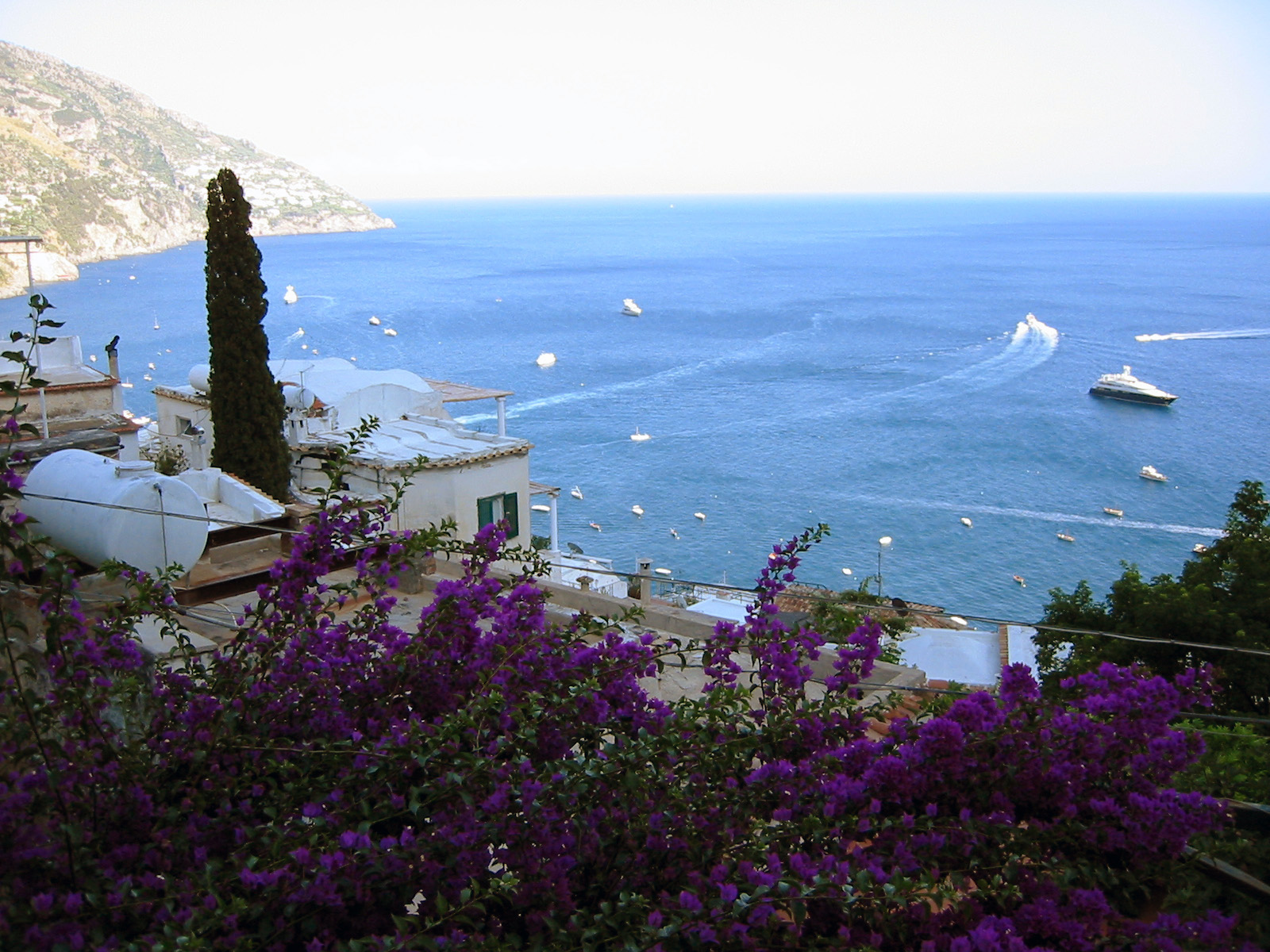
Amalfi Coast – July 4
With a good map, it’s pretty easy to drive the streets of Rome. We ventured south, along the old Appian Way, reflecting on the history of this narrow little street, still barely wide enough for 8 soldiers across. We tried to imagine the rows of crucified slaves during the revolt of Sparticus that lined this entrance to Rome, or the columns of Roman soldiers marching back to the city after long months of foreign campaigns.
It was a long drive down the Amalfi coast but the reward was Positano. A remarkably beautiful town built into the Amalfi hills with breathtaking views of the acquamarine Mediterranean.
Our friend Lisa has been trying to get us to visit her Positano villa for at least four years and finally here we were, albeit for just one night.
After a light lunch with Lisa and Marcello and a good nap overlooking the Amalfi Bay, we ventured out to meet some of Lisa’s friends. All in all, a good visit, a great meal by the water and some pretty interesting people. Isn’t that what travel is all about?
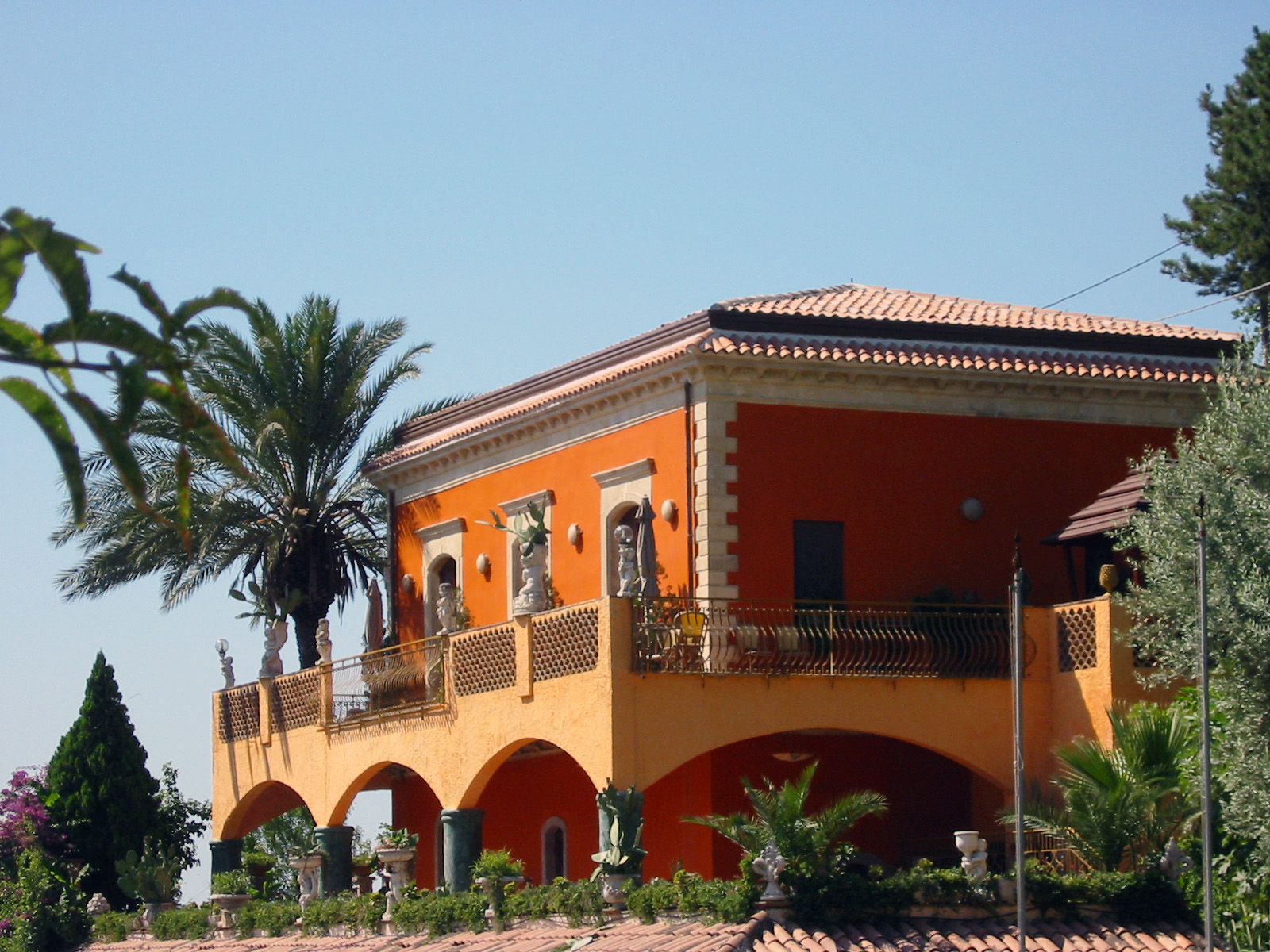 Sicily – July 5
Sicily – July 5
The Villa Due Angeli, our rental home in Sicily is inland from the old seaside resort of Taormina, near the small fishing village of Giardini Naxos (now a very popular tourist beach destination). From the top of the Villa you can barely see the Mediterranean. This renovated old winery house is owned by Phil, a former Hollywood assistant film director (HonkyTonk Freeway), food caterer to the LA Gliterati and ceramic artist, and his lover Carmelo, an artist-designer and former fashion model for Hermes and Versace who has an accent that sounds more like a Corsair pirate than a Sicilian. Also in the mix was Phil’s niece Kathy, a film accountant trying to patch things up with her stuntman husband who’ll be arriving later on in the week, Cocoa, the little beige dog with a large rhinestone collar, and two cats, RainyWoos and BabyWoos. The original cat, PussyWoos had one too many adventures on routeSS185, but we’ll get into Sicilian drivers a little later. It’s a real dysfunctional Hollywood story here, playing out in the idyllic Sicilian countryside. Phil’s sister Kathy also reveled to me that she has Fabian’s phone number at the tip of her fingers. It’s amazing that anyone even knows who Fabian is anymore.
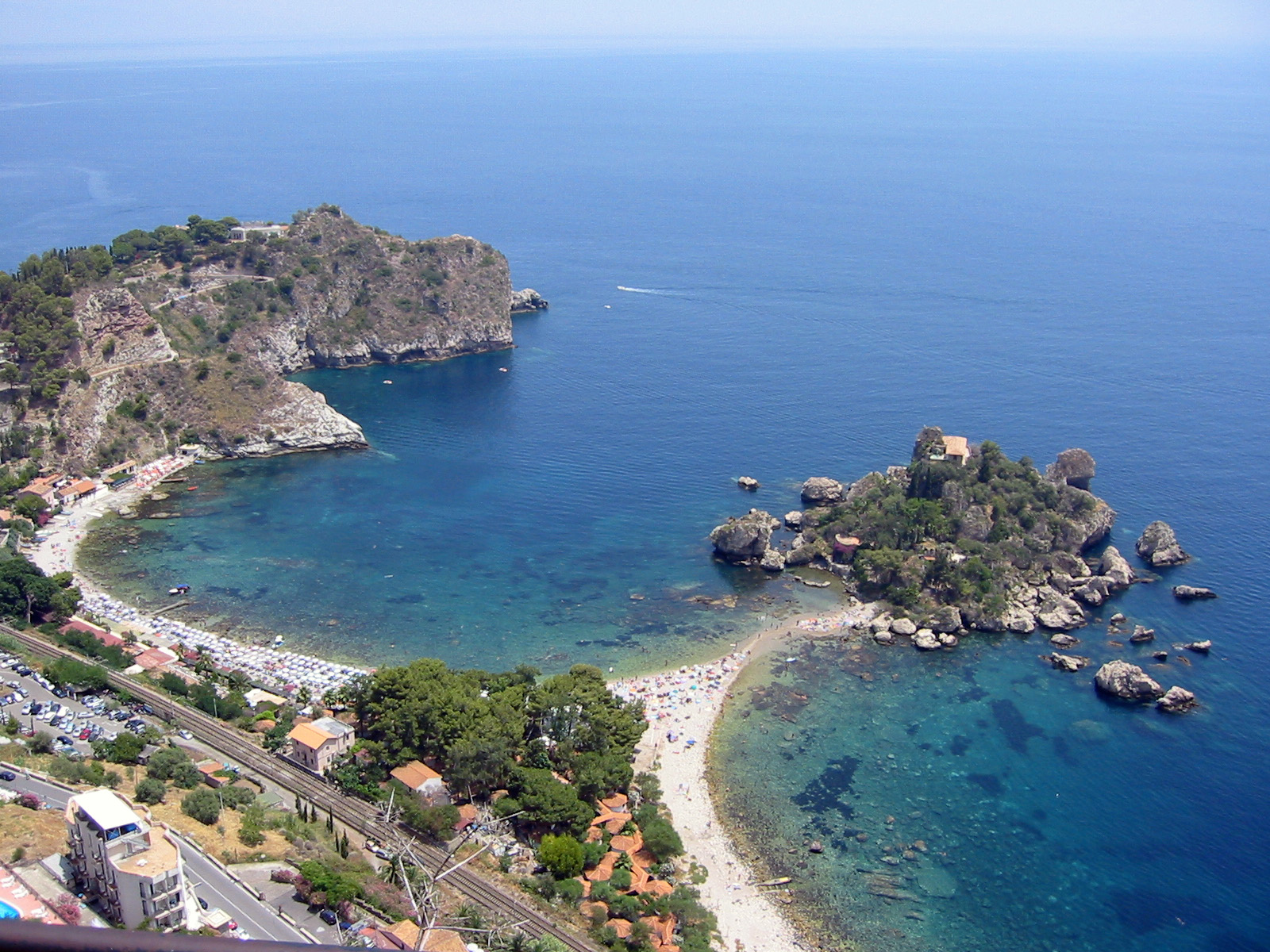 July 6
July 6
Taormina has been a tourist town since Ancient Greek times. And why not. It’s a beautiful location with breathtaking views. Although, in ancient times, the walk from the town above to the beach below must have been an all day affair, the recent installation of the Funivia (cable car) gets you up and down in less than 10 minutes. Eager to get our toes into the Sicilian Mediterranean water, we found a small rock about 40 ft off the coast and perched ourselves down like seals. While I laid back on the rock, Gretch jumped right in and immediately discovered the discomfort of sea urchins. I ended up with orange feet from the leather dye of my sandals bleeding onto my skin as I walked out of the rocky sea.
Back at the Villa, Phil entertained us with catering tales of rolling Betsy Bloomingdale across the floor to put out the fire in her dress and running out of cognac at a Jackie Onassis affair and having Mrs Onassis instruct him to “finesse the cognac”, which Phil understood as just water it down.
July 7
As we’ve learned over and over again, maps can also be deceiving. They always show the big roads but in many cases, the these roads are in the construction phase and aren’t completed yet. This gives the map company the advantage of not having to recreate the map every year. However, this gives us the disadvantage of having to spend an extra two hours behind a slow truck spewing black exhaust on a winding road almost a third of the way to Cefalu, and a really beautiful beach along the clear acquamarine Tyrrhenian Sea embracing the narrow medieval streets of this purely picturesque town. Above the miles of creamy sand are the craggy hills and the ruins of a 12th century Norman Castle.
 It cost 16 euros to rent 2 lounge chairs with umbrellas, but it was worth every centissima. We would have paid even more if they offerred suntan lotion. Four days later, as I’m writing this, my skin is still sore.
It cost 16 euros to rent 2 lounge chairs with umbrellas, but it was worth every centissima. We would have paid even more if they offerred suntan lotion. Four days later, as I’m writing this, my skin is still sore.
Piazza Amerina and the Villa Romana del Casale
Towards the center of the island, the partched mountains and dried wheat farms turned a baked amber color as we drove by countless deserted houses and farms. By the time we reached the 4th century Roman, Villa Romana del Casale outside the town of Piazza Amerina, the heat rose to a toasty 40° C. It was so hot, not only did the tourists stay away, the tents of vendors hawking tee shirts and souvenirs outside the attraction were closed. Everyone stayed home. Everyone but us, another small group of Americans and a few French families.
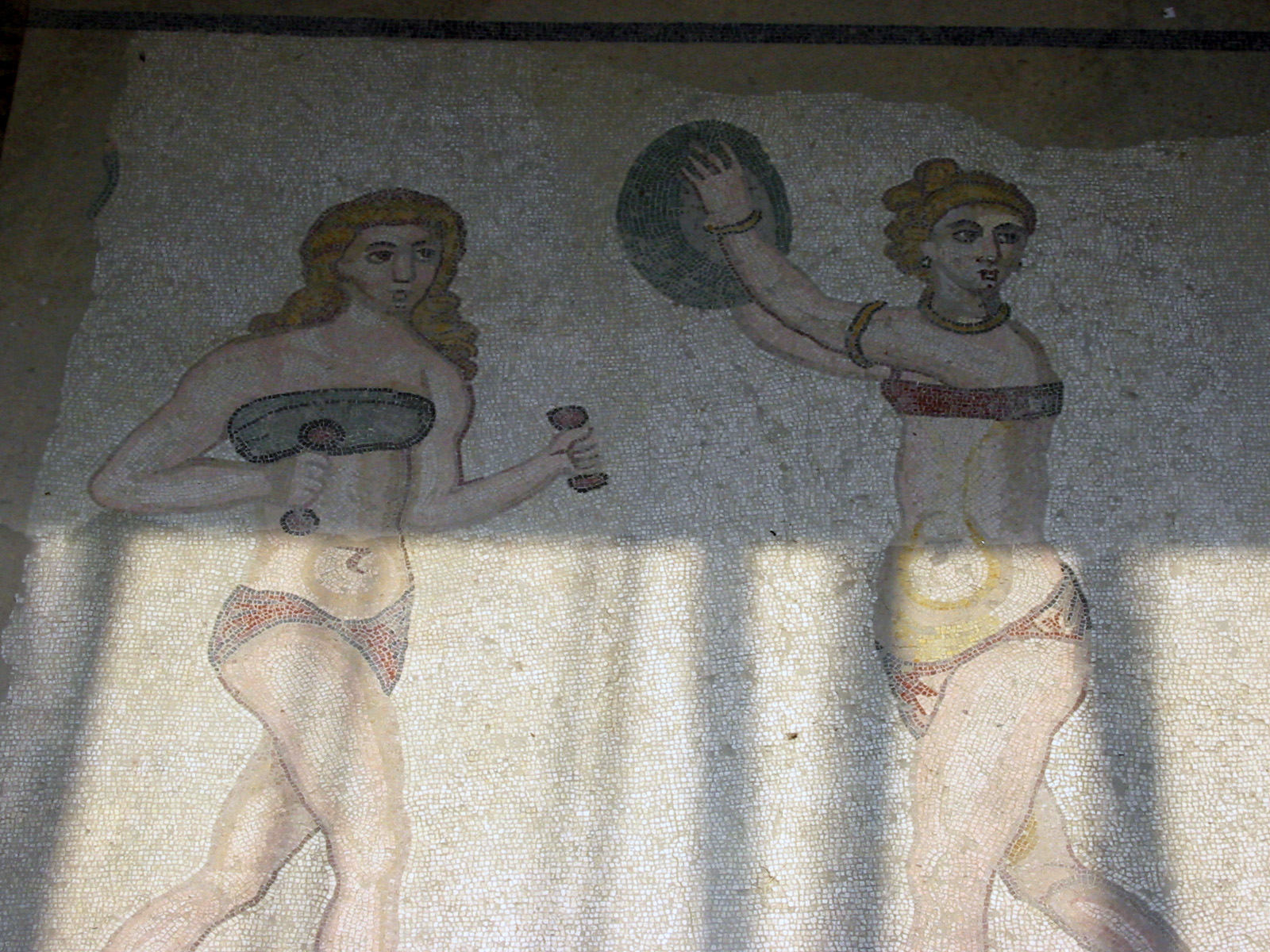 The nobile Roman family who built this very large villa chose the location because of the nearby hot springs and fresh water river, both of which dried up long ago. But what has remained are some of the best preserved ancient mosaic floors in the world, hundreds of square feet of amazing detail, color and design; floors telling tales of great hunting trips, recreations of favorite myths, a woman’s quarters adorned with bikini clad girls working out with free weights, a childrens’ wing with children hunting scenes, a music and poetry room, a 3 eyed Cyclops. We’ve seen lots of mosaic pieces at least as old as this, but seen anything this big in it’s original location.
The nobile Roman family who built this very large villa chose the location because of the nearby hot springs and fresh water river, both of which dried up long ago. But what has remained are some of the best preserved ancient mosaic floors in the world, hundreds of square feet of amazing detail, color and design; floors telling tales of great hunting trips, recreations of favorite myths, a woman’s quarters adorned with bikini clad girls working out with free weights, a childrens’ wing with children hunting scenes, a music and poetry room, a 3 eyed Cyclops. We’ve seen lots of mosaic pieces at least as old as this, but seen anything this big in it’s original location.
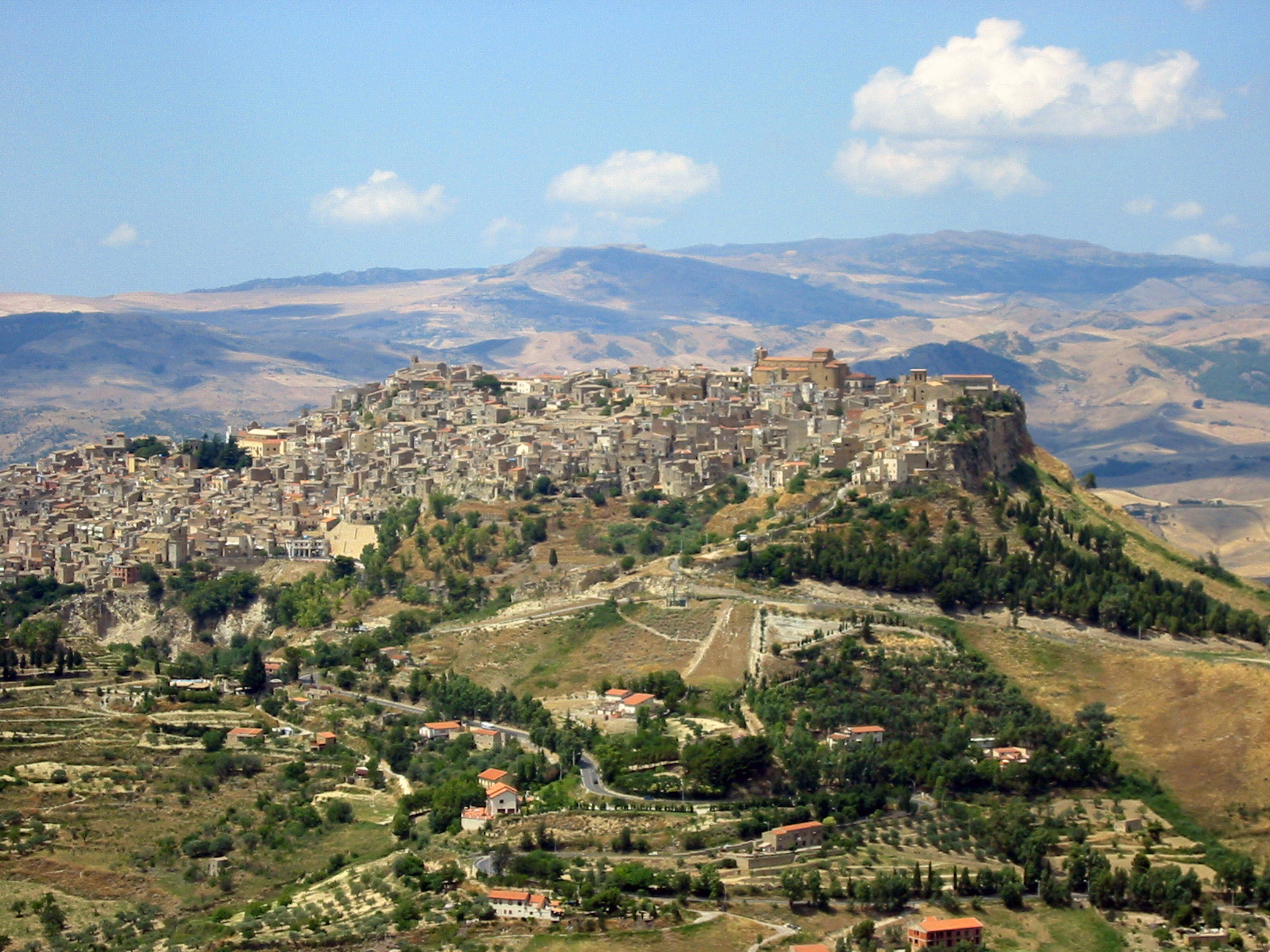 Enna
Enna
We climbed up to the highest point of the island, the mountain city of Enna, siting around 3,000 feet above the rest of the island. This is where Pluto abducted Persephone, although it’s odd why he didn’t chose a place closer to Hades. Enna has been called the “Belvedere” (beautiful view) as well as the “Ombelico” (the belly button) of Sicily. It commands an amazing view. It’s been a chosen Military post since before the time of Dionysius of Siracusa in ancient Magna Grecia.
Unfortunately, our visit here was a short one. We arrived around 2:30pm, right in the middle of the “out to lunch” part of the day. On the mainland of Italy many businesses in populated areas are adopting the non-stop workday, but here in rural Sicily, the old cultural habits prevail. Work stops at 1pm and doesn’t open back up till 3:30pm at the earliest. Being that this was August, even most of the restaurants were closed. We parked the car, had a nice walk, took a few photos and left.
Siracusa
As with a lot of European cities, you really need to drive through the incredibly ugly exterior before you find the prize inside. Syracuse is a good example of this. The old town dates back to 733 BC. The Greek glory of Magna Grecia under Dionysius pretty much ended when the tyrant/king and frustrated writer finally beat Athens in a poetry contest and then drank himself to death in celebration.
Around 200BC it was the time of “Eureka, I found it” Archimedes, who not only figured out the theory of specific gravity (or that the gold crown for gods of Delphi was a fake), he also discovered the value of Pi and invented some really cool war machines, including a mirror that could harness the heat of the sun and burn the enemy ships in the harbor.
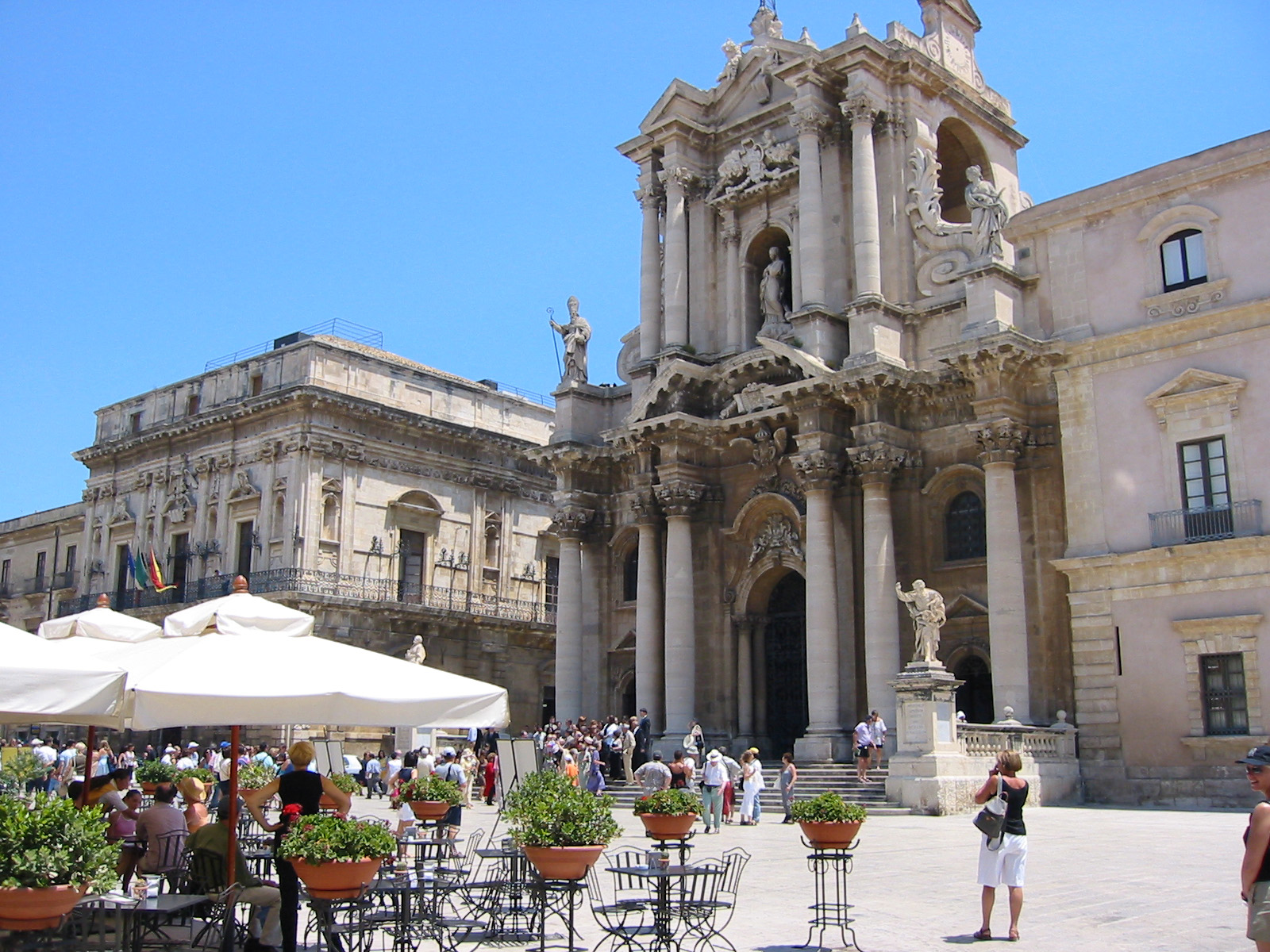 Siracusa eventually moved into the hands of the Romans, the Cathaginians, the Vandals, Ostrogoths and Normands. And if all these changes in history weren’t enough, in 1693, Mt Etna blew up and whacked many of the beautiful buildings into rubble. The German and Allied bombing raids of the 1940’s added to the rubble. But even after all the destruction, the Renaissance and Baroque buildings of the Ortygia decorate the harbor like the painted palaces of Venice. The remains of the ancient Greek and Roman city are still there; the Amphitheatre, the Greek Theatre, the various temples ruins and the really wonderful archeological museum.
Siracusa eventually moved into the hands of the Romans, the Cathaginians, the Vandals, Ostrogoths and Normands. And if all these changes in history weren’t enough, in 1693, Mt Etna blew up and whacked many of the beautiful buildings into rubble. The German and Allied bombing raids of the 1940’s added to the rubble. But even after all the destruction, the Renaissance and Baroque buildings of the Ortygia decorate the harbor like the painted palaces of Venice. The remains of the ancient Greek and Roman city are still there; the Amphitheatre, the Greek Theatre, the various temples ruins and the really wonderful archeological museum.
The great columns of the enormous Temple to Athena now support the apse of the grand Santa Lucia cathedral in the Piazza Del Duomo (the photo to the right). The temple remains. Only the gods have changed.
Taormina
We got back to Taormina around 7pm and after herding through the narrow medieval streets for a couple of hours along with the thousands of tourists, we finally found our way through the crowd up to the ancient Greek Theatre to see the Diana Krall concert. What a spectacular place for a concert, sitting up in the circular rows of stone and watching Diana against the backdrop of the ancient Greek ruins. Through the remains of the great upstage columns, the magical Mediterranean below. Over half way through the show, the audience began to strike matches to small thin candles and soon the dark abyss became an enchanted sea of lights.
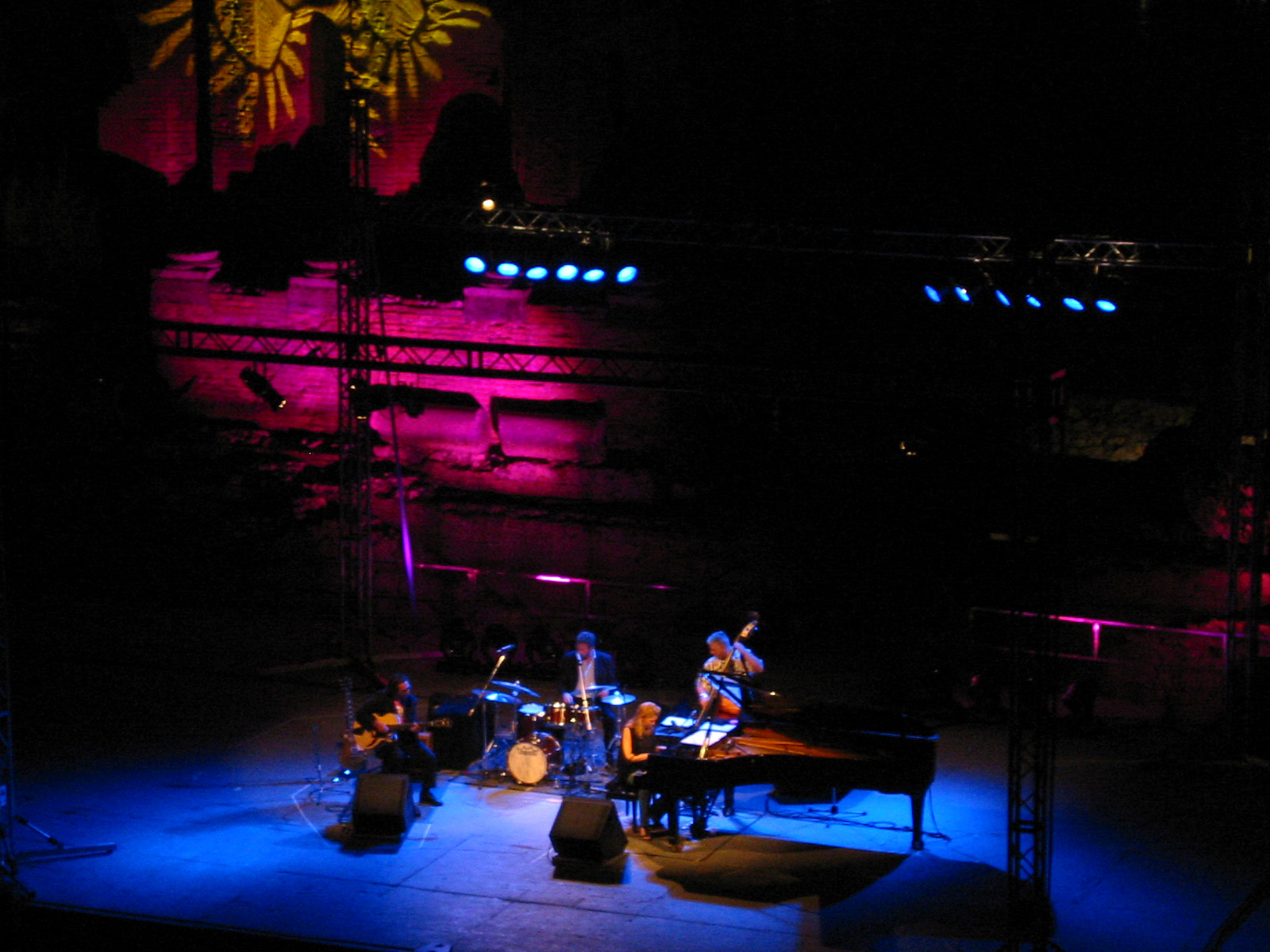
As Diana Krall looked up from the piano and saw the thousand points of light (take that George Bush the 1st) she said “damn, I wish I had a camera with me. And soon after one of her stagehands was sitting on the upstage ruins snapping photos of the audience while the audience was snapping photos of the concert.
I Ciclopi
In October of 2002, Mt Etna burped and sent black ash over the eastern part Sicily from Messina to Catania. The tour books we are traveling with told us that if we got to the 1910 meter stop at the Refugio Sapienza, we’d be able to take the Funivia (cable car) up another 1000m to the high Observatory. But as we arrived to Refugio Sapienza, the road had turned from blacktop to rubble. Backhoes and rock crushers were busy clearing out volcanic debris. The souvenir shops were open for business but all that remained of the Funivia were the towers that once carried the cable for the cable cars. The 2002 eruption not only knocked out the cable car system, it also took out a nearby restaurant with 32 people inside. Ten months later, they’re still cleaning up. This is one powerful volcano. We were allowed to walk around one of the smaller craters near the Refugio but we never got to the top. There are lots of these old craters set into the face of mountain, like pimples building up pressure, getting ready to pop.
The Cyclops were a race of blacksmiths who achieved glory by forging Zeus’s mighty thunderbolt. But after this one formidable glory, they regressed into a tribe of clumsy sheep herders who crushed their enemies with large boulders and developed a taste for human flesh. Some races evolve, others don’t.
 But anyway, as the story goes, after Odysseus tricked the Cyclops Polyphemus by getting him drunk, he poked his eye with a red hot poker and escaped with his men from the cave by attaching themselves to the bellies of Polyphemus’ sheep . They made it back down the mountain to the safety of his ship, but the story didn’t end there. Odysseus just couldn’t leave without getting a few more victorious digs into the wounded Cyclops, and so he and the crew hurled insults up the cliff as they set sail out of the harbor. In turn, Polyphemus hurled down some extremely large rocks at them. Odysseus made it safely out of the harbor but these rocks, known as “I Ciclopi” are still there off the coast of Aci Trezza. One of our guide books that told us this Riveria dei Ciclopi was one of the best beaches in Sicily. The rocks that Polyphemus threw into the sea are definitely impressive but where’s the damn beach. We walked along the coast for at least an hour and all we saw were people lying on volcanic rocks looking like white seals. It’s a beach with no sand, just lots of volcanic rock. Ouch….
But anyway, as the story goes, after Odysseus tricked the Cyclops Polyphemus by getting him drunk, he poked his eye with a red hot poker and escaped with his men from the cave by attaching themselves to the bellies of Polyphemus’ sheep . They made it back down the mountain to the safety of his ship, but the story didn’t end there. Odysseus just couldn’t leave without getting a few more victorious digs into the wounded Cyclops, and so he and the crew hurled insults up the cliff as they set sail out of the harbor. In turn, Polyphemus hurled down some extremely large rocks at them. Odysseus made it safely out of the harbor but these rocks, known as “I Ciclopi” are still there off the coast of Aci Trezza. One of our guide books that told us this Riveria dei Ciclopi was one of the best beaches in Sicily. The rocks that Polyphemus threw into the sea are definitely impressive but where’s the damn beach. We walked along the coast for at least an hour and all we saw were people lying on volcanic rocks looking like white seals. It’s a beach with no sand, just lots of volcanic rock. Ouch….
Sicily is a big island and it takes a long time to anywhere, but getting there is usually worth the trip, even though Sicilian drivers are the worst on the planet. I could go on for pages talking about how they stick the nose of their cars half way through an intersection trying to force you to stop so they can get through, or how they sit barely a few feet away from the ass of your car while your going 140km on the Autostrada. Traffic lights are suggestions to stop or go, no one really pays any attention to them. Everything is fair game for passing, right lanes, left lanes, sidewalks… They’ll cut you off every chance they can get, and if you have foreign plates, or even license tags from other parts of Italy, you are fair game for Sicilian road intimidation. Let’s just say it’s pretty bad.
We have discovered real granita here. Sure we’ve had it in Spain and other parts of Italy, but granita in Sicily is a whole other thing. We broke ourselves in with lemon and mandorla (almond) but there’s a whole world of flavors of this creamy Italian ice. And speaking of mandorla, this is the place for anything almond. The marzipan art here is the most realistic we’ve ever seen, the almond pastries are to die for, or how about a spread of almond cream on a piece of bread. Then there is latte di mandorla, that mixture of almond cream and water that tastes like a milkshake. We just can’t get enough of this stuff.
In the search for new and wonderful wines, we’ve discovered the Nero D’avola grape. This dark purple wine carries a 13%-14% alcohol volume, wonderful perfume, lots of forward fruit, very soft tannins and drinks very young. If you can fid them, check out Fegotto, Scyri, Planeta and Rosso de Canto by Taca D’Almerita. There are also some great Nero D’Avola/Syrah blends. And speaking of the syrah grape, there are many wine authorities on this island who have assured me that the origin of this grape variety is from Sicily, originally cultivated in Syracusa, hence the name Syrah. One fellow told us that a 2000 year old tomb in the region uncovered a seed from the syrah grape. I wonder what the French think about that?